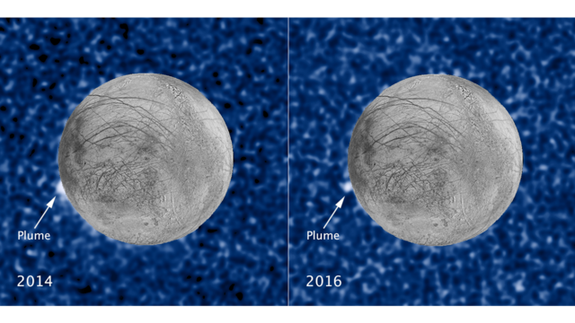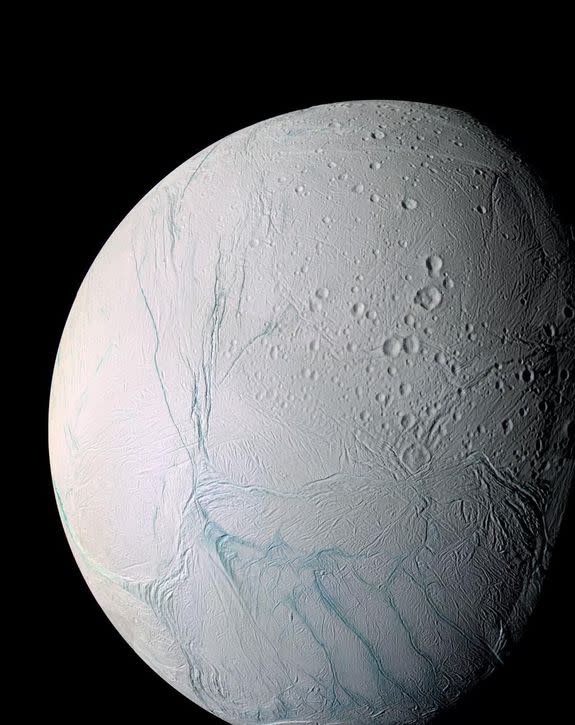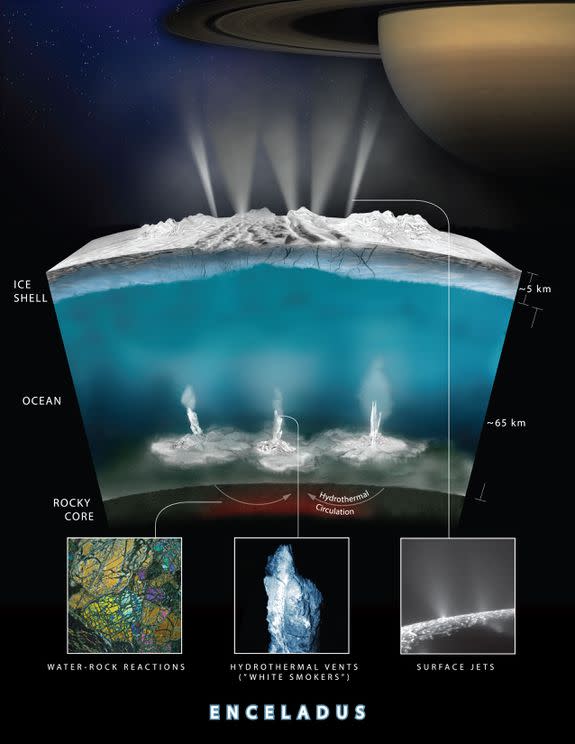NASA finds key ingredients for life pouring out of Saturn's icy moon Enceladus

Evidence is increasing that liquid water and other building blocks for life exists on two icy moons in our solar system, NASA researchers announced.
The exciting new insights, revealed in a Thursday news conference, came from data gathered by the Cassini spacecraft probing Saturn and the Hubble Space Telescope.
SEE ALSO: Amazing Video of Planets, Stitched Together from NASA Photos
The Cassini scientists said Saturn's moon Enceladus appears to play host to both liquid water and chemical energy that's required for life to exist, such as carbon, nitrogen, oxygen, and hydrogen.
Hubble researchers also reported new evidence of what they believe are hydrogen plumes erupting from Jupiter's moon Europa.
The scientists published two research papers on their findings. The paper related Saturn's moon, published in the journal Science, shows that hydrogen gas — which could potentially provide a chemical energy source for life — is pouring into a subsurface, liquid ocean of Enceladus from hydrothermal activity on the seafloor.

Image: NASA/ESA/STScI/USGS
Enceladus is a small, icy moon located a billion miles farther away from the sun than the Earth is, NASA said.
An icy crust lies atop the moon's liquid ocean. The presence of ample hydrogen in the ocean means that microbes at the bottom of the food web — if any exist — could use hydrogen to obtain energy by combining it with carbon dioxide dissolved in the water. Such a chemical reaction produces methane as a byproduct, and forms the root of Earth's own tree of life.
"Enceladus has almost all of the ingredients that you would need to support life on Earth," said Linda Spilker, Cassini project scientist at NASA's Jet Propulsion Laboratory in Pasadena, California, during the press conference.

Image: NASA/JPL/Space Science Institute
The chemical ingredients of life include carbon, hydrogen, nitrogen, oxygen, phosphorus, and sulfur. The new findings indicate Enceladus has nearly all of these ingredients, thought that does not guarantee there are microbes or other life on the tiny, icy moon.
"Confirmation that the chemical energy for life exists within the ocean of a small moon of Saturn is an important milestone in our search for habitable worlds beyond Earth," Spilker said in a statement.
The Cassini spacecraft detected the hydrogen in the plume of gas and icy material spraying from Enceladus during its last, and deepest, dive through the plume on Oct. 28, 2015.

Image: NASA/JPL-Caltech
Cassini also sampled the plume's composition during flybys earlier in the mission. These observations show that nearly 98 percent of the gas in the plume is water, about 1 percent is hydrogen and the rest is carbon dioxide, methane, and ammonia.
"Although we can't detect life, we've found that there's a food source there for it. It would be like a candy store for microbes," Hunter Waite, lead author of the Cassini study, said in a statement.
The Cassini mission is scheduled to end in early September.
The paper on Jupiter's Europa moon, published in The Astrophysical Journal Letters, contains the new Hubble Space Telescope findings. Observations detected a plume of material erupting from the moon's surface at the same spot where Hubble saw evidence of a plume in 2014.
The images add to the evidence that flares of water vapor may be shooting out from the moon's surface, though they do not prove this with certainty. The Europa plumes appear to be rising from an unusually warm region in the moon's icy crust, indicating that it could be the result of water emanating from the moon's interior.
NASA is planning for a new mission known as the Europa Clipper mission, which is currently slated for the early 2020s.
"If there are plumes on Europa, as we now strongly suspect, with the Europa Clipper we will be ready for them," said Jim Green, Director of Planetary Science at NASA.
